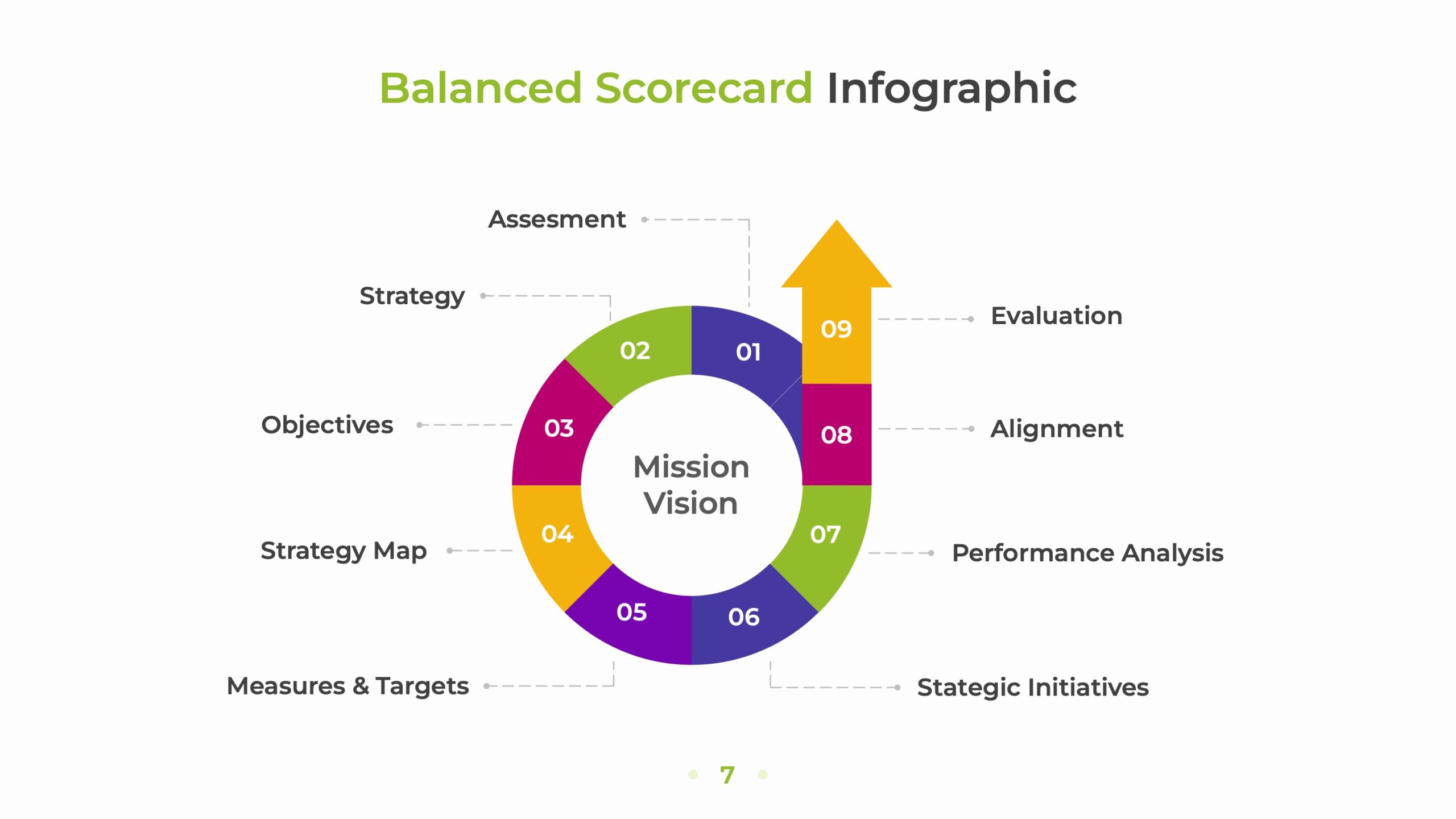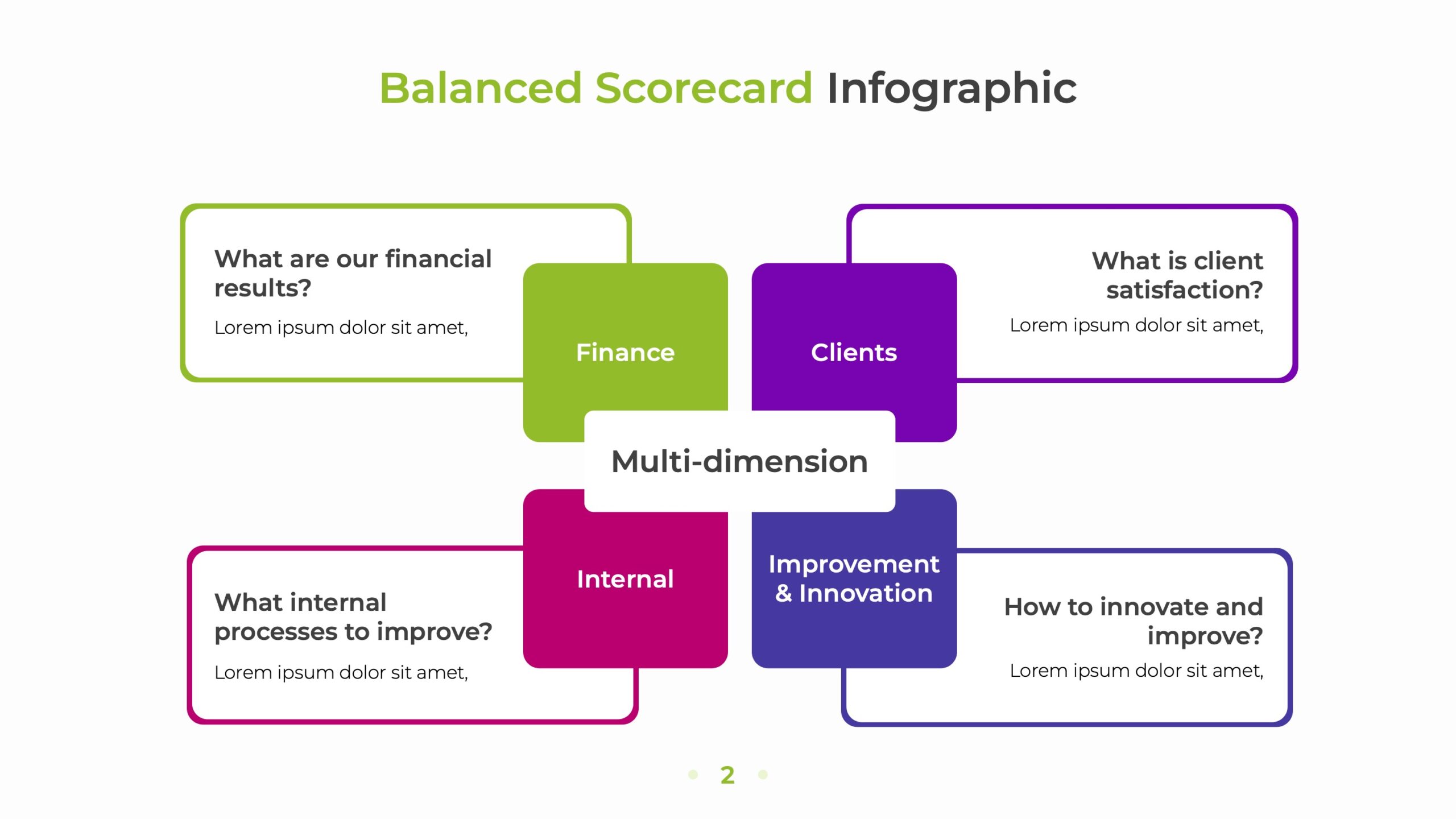Balanced Scorecard Template Powerpoint: A Comprehensive Guide
Table of Contents
In the quick-moving world of business it crucial for companies to really know what they aims and goals is. This keep them on track and let them make smart choices that leads to expansion and success. The Balanced Scorecard Template Powerpoint give an all-inclusive structure for businesses in managing their performance and reaching them strategic targets.
This manual is gonna give you a detailed look at the Balanced Scorecard Template Powerpoint and how it can be use for boost your organization’s performance. We gonna talk about what exactly a balanced scorecard be, the advantage of using one, how you create them with the template and some advice for putting it to work right in your company.
What is a Balanced Scorecard Template?
 A Balance Scorecard Template be a strategy managements tools that help organization to define and keep track of they goals, metrics, objectives and projects in a picture form. It give a clear vision for the company’s total performance and assist in lining up it activities with it aims. Robert S. Kaplan with David P. Norton first bring out this template in the early 1990s as an tools for measuring how good things are going, since then it have turned into a commonly used structure for strategize plan and manage stuff.
A Balance Scorecard Template be a strategy managements tools that help organization to define and keep track of they goals, metrics, objectives and projects in a picture form. It give a clear vision for the company’s total performance and assist in lining up it activities with it aims. Robert S. Kaplan with David P. Norton first bring out this template in the early 1990s as an tools for measuring how good things are going, since then it have turned into a commonly used structure for strategize plan and manage stuff.
The templates got four key views – money stuff, clients doings, what goes on inside and the smarts and getting better bits. Every angle show an important part of how a company does things helping make sure they sees things straight about how they’re doing. Money-wise it’s all ’bout how much cash they making more profits and cutting down on spending.
Customers views look on how a company meets their client’s needs and what they expects. Internal process perspective review if the company’s main business tasks is efficient and effective for make sure them achieve goals. Lastly learning and growth aspect measure how good an organization can adapt innovate and gets better as time goes by.
Benefits of Using a Balanced Scorecard Template

The Balanced Scorecard Template Powerpoint offers numerous benefits for organizations that utilize it effectively.
Firstly, it provides a comprehensive view of an organization’s performance by considering all key aspects and objectives. This helps identify any imbalances or gaps in the organization’s strategy and allows for corrective actions to be taken.
Secondly, the template promotes communication and collaboration within the organization. Since it is a visual tool, it can be easily understood by all stakeholders, leading to a shared understanding of the organization’s goals and objectives. This also leads to better alignment of activities and decision-making processes.
Thirdly, the Balanced Scorecard Template can help create a performance-driven culture within an organization. By clearly defining objectives and measures, employees are motivated to work towards achieving them. It also provides a basis for performance evaluation and feedback, leading to continuous improvement.
Finally, this template can be used as a tool for strategic planning and decision-making. By regularly tracking performance against targets, organizations can make data-driven decisions that drive growth and success in the long run.
How to Create a Balanced Scorecard using the Template?

Using the Template to make a Balanced Scorecard is simple it only have four main steps
Identifying objectives
Firstly they identifies what the organization wants to reach. Them goals must be in line with what the group stands for and where it sees itself going. The aims need to check off all boxes: specific measurable doable important and within a time frame (SMART). The four viewpoints of the template give directions on this by looking at different parts like money targets, what people buying stuff want and think they should get bettering how things work inside, and helping workers grow.
After goals is identified they can be turned into main performance indicators for each view. These KPIs needs to show the success of them objectives and gives a definite way to measure success. Then targets could be made for every KPI so progress gets tracked over time.
Moreover it are important for to be putting the main goals first and to pay attention on them that is most needing it. Doing this stops too much work piling up and make sure energy go where they matter a lot in company.
Selecting measures
Next steps involve choosing which measures for track how good the organization do in moving closer to it goals. The measures need be precise, matter a lot and mirror the objectives them supposed to measure. They is able to be number-based or quality-based depending of what kind of goal is being looked at.
An example of measuring how happy customers is can be looking at the Net Promoter Score while you could check the ratio of workers who’s done training programs to see if employee growth is happening.
Keeping measures simple and manageable are important. Having too many measures can create confusions and leads to decision-makings that aren’t effective. Also ensuring that the measures is in line with an organization’s overall strategy be crucial instead of just being isolated data point.
Setting targets
Goals needs to be established for every action so that there is a standard to measure triumph. These goals must push the limits but still they can reach it and showcase what performance level the organization wants. It could relies on past info industry standards or selves objectives.
Making goals make workers feel like they need to hurry up and help them want to reach the company targets. It lets us see how far we’ve come and fix things that ain’t right as we goes along.
Also targets need to get looked at often and change them when necessary so it match any shifts in the organization’s strategy or outside things.
Defining initiatives
The last thing to do is decides which efforts they will be helping meet the group goals. These initiatives could be project, programme or action that pushes forward to meeting those aims. They needs to be detailed and must got defined timescales and who’s in charge.
Essential to line up initiative with the goals and they measures so that they contributes to overall performance It also crucial prioritize initiatives base on they impact and feasibility.
Creating the Balanced Scorecard
After all them steps is finished, it be time for crafting the Balanced Scorecard with template provided. This template give a picture of company’s goals, metrics, aims and plans for every angle.
Regularly reviewing and updating the Balanced Scorecard it’s important for reflecting any changes in organization strategy or external factor. This lets continuos improvement and make sure that organization stay focusing on they goals.
Additionally Balanced Scorecard is able to be shared with stakeholders for encouraging talks and working together. It also can acts as foundation for judging performance and making choices which pushes organization toward achieving success.
Why Regular Monitor and Reviews on a Balanced Scorecard Is Importants?
Regular checks and reviews of Balanced Scorecard be critical for many reasons. First it let for track progress toward goals and targets. This enable organizations to find any areas that needs improvements or adjustments and take needed actions.
Secondly regular monitoring and reviewing helps in catching any problems or obstacles early which allows for interventions at the right time. This stops little issues from becoming big troubles and keep organization on path for accomplishing they goals.
Furthermore regular checks and looking over things makes sure that everyone can see through the company, making sure it’s honest. When workers knows they’re being watched on how well they does their job they tends to work harder for hitting them goals, helping with the big win for all.
Also they regularly look at Balanced Scorecard companies make sure it stay in line with their big plan. This let for bending and change when market conditions or business important things switch up.
Furthermore, regular monitoring and review of the Balanced Scorecard foster a culture of continuous improvement within the organization. By regularly evaluating performance and identifying areas for improvement, organizations can strive towards excellence and stay ahead of the competition.
Does the Balanced Scorecard Have Limitations?
Like any management tool, the Balanced Scorecard also has its limitations. One of the main limitations is that it can be time-consuming and resource-intensive to implement and maintain. This may be a challenge for smaller organizations with limited resources.
Moreover, the Balanced Scorecard is based on a top-down approach, where objectives and targets are set by upper management. This can lead to a lack of buy-in from employees who may feel disconnected from the goals and measures.
Additionally, the focus on key performance indicators may lead to neglecting other essential areas of the organization that do not have specific measures. This could result in a narrow view of overall performance.
Furthermore, the Balanced Scorecard may not account for external factors such as changes in the market or competition, which can impact an organization’s performance. This requires regular review and adjustment of the Scorecard to ensure its relevancy.
However, despite these limitations, the Balanced Scorecard remains a valuable tool for organizations to align their strategy and measure their performance across various perspectives. With proper implementation and regular monitoring, it can drive an organization towards success and continuous improvement.
Where to not use Balanced Scorecard?
The Balanced Scorecard, just like other management tools comes with its own limits. A major limit is it take too much time and need a lot of resources for set up and keep going which be hard for little companies that don’t have much stuff or money.
Furthermore the Balanced Scorecard relies on a top-down method where goals and targets gets set by higher-ups. This might cause employees to not feel committed because they feels detached from those objectives and metrics.
Moreover, focusing on the key performance indicators might makes other important parts of the organization what don’t have specific measures to be overlooked. It could lead to a limited perspective of overall performance.
Moreover the Balanced Scorecard might not takes into consideration for outside influences like shifts in market or competitive forces which affects a company’s performance. They needs constant checking and tweaking of this Scorecard to maintain it’s relevance.
Even with them limitations, the Balanced Scorecard keep as a useful tool for organization to lining up their strategy and measuring performance across different views. When it properly implemented and monitored regular, it can push an organization toward succeed and constant betterment.
Where to not use Balanced Scorecard?
The Balanced Scorecard might be handy for a lot of companies but in some cases it not work well or fit right. Main thing is small businesses with not much to spare could find that the Scorecard takes too much time and hard work more than what it’s worth for them companies.
Moreover, Balanced Scorecard might not fit for goals that’s short-term or quick to change since it take a lot of time and efforts to make objectives measures targets and initiatives. In these cases other performance management tool could be better suited.
Additionally in these days business realm as digitalization and data-driven choices gets more common the Balanced Scorecard may not holds as much importance. Company now have access to live data and analytics they gives them deeper and correct insights on how they performing.
Moreover, the Balanced Scorecard might not fit companies that’s structure is very complicated and change a lot. It can get tough to make goals and metrics line up good among different department or parts of the business.
In final consideration it important to take in account the company culture and how much employees is on board before putting into action the Balanced Scorecard. When theirs a missing of trust or comprehension amongst staffs, that Scorecard might not work as good for pushing performance and encouraging teamwork.
Things to be Careful of While Putting into Practice Balanced Scorecard
Putting in place the Balanced Scorecard can be tough work and they’re several usual blunders that organizations need to dodge. A really big mistake is acting like the Scorecard’s a one-off task instead of a never-ending process. The Balanced Scorecard needs steady watchfulness and checking to stay useful, and organization have got to set aside resources for its upkeep.
One error to dodge is coming up with too much targets or goals that might cause too many datas and mix-up. It’s important for focus on a handful of main performance indicators that fits with they organization’s big plan.
Furthermore, it be crucial that all stakeholder get involved in development and put into practice of Balanced Scorecard. This mean employee from every level along with customers and other outsider stakeholder. They feedback and agreement is key for scorecard to succeed.
Companies shouldn’t use the Balanced Scorecard for judging how good their workers are doing or for deciding pay. This can create a negative connotation around the Scorecard and hinder its effectiveness in driving performance.
Furthermore, it is vital to regularly review and adjust the Scorecard to ensure its relevancy and alignment with the organization’s strategy. Neglecting to make necessary changes can result in a disconnect between objectives and actual performance.
Does the Balanced Scorecard Work for Every Organization?
No, the Balanced Scorecard may not be suitable for every organization. While it can be a valuable tool in aligning strategy and measuring performance, there are certain factors to consider before implementing it.
Firstly, the size and structure of an organization can play a significant role in determining the effectiveness of the Balanced Scorecard. Smaller organizations with limited resources may find it challenging to implement and maintain the Scorecard, while larger and more complex organizations may struggle to align objectives across different departments or business units.
Moreover, the organization’s industry and market conditions can also impact the suitability of the Balanced Scorecard. For industries that require quick adaptation to changing market trends, a more agile and dynamic performance management tool may be more suitable.
Additionally, the organizational culture and employee buy-in are crucial for the success of the Balanced Scorecard. If there is a lack of trust, understanding, or commitment from employees, it can hinder the effectiveness of the Scorecard in driving performance.
Furthermore, organizations must evaluate their goals and objectives before implementing the Balanced Scorecard. If they are focused on short-term or rapidly changing goals, the Scorecard may not be as effective in providing relevant insights and measures.
FAQs
What are balanced scorecard templates for PowerPoint?
Balanced scorecard templates for PowerPoint are pre-designed presentation slides that help organizations visualize their business strategy through various perspectives, including financial, customer, internal process, and growth. These templates provide a structured way to present strategic targets and KPIs (Key Performance Indicators) to stakeholders.
How can I find balanced scorecard PowerPoint templates for my business strategy presentation?
You can find balanced scorecard PowerPoint templates by searching online for reputable sources offering business and operational management templates. Additionally, Microsoft PowerPoint and Google Slides have built-in template galleries where you might discover templates suitable for presenting your balanced scorecards and strategic planning efforts.
Can balanced scorecard slides in PowerPoint help with strategic planning?
Yes, balanced scorecard slides in PowerPoint are an excellent tool for strategic planning. They allow you to clearly define and communicate your strategic targets, operational management goals, and the KPIs necessary to measure success across different perspectives of your organization.
What should I include in a balanced scorecard PowerPoint template to cover the internal process perspective?
In your balanced scorecard PowerPoint template, covering the internal process perspective involves including slides that detail the key processes that need to be optimized to satisfy customer and financial objectives. This may involve showcasing operational improvements, innovation processes, and quality control measures that contribute to achieving strategic goals.
Conclusion
In conclusion, the Balanced Scorecard can be a valuable tool for organizations to align their strategy and measure their performance. However, it is not suitable for every organization or situation. Careful consideration of factors such as size, structure, industry, culture, and goals must be taken before implementing the Scorecard.
Furthermore, avoiding common mistakes in its implementation and regularly reviewing and adjusting the Scorecard can ensure its effectiveness in driving success and continuous improvement for an organization.
So, it is essential to assess an organization’s specific needs and circumstances before deciding to use the Balanced Scorecard as a performance management tool. Ultimately, with proper implementation and maintenance, the Balanced Scorecard can help organizations achieve their desired objectives and contribute towards long-term success.
Related Blogs
Get 7+ Mio. PowerPoint Assets - FREE SIGN-UP

Sign up for free to our PowerPoint extension, ExpertSlides. Everything you need, directly in PowerPoint. No credit card required.
Related Posts
